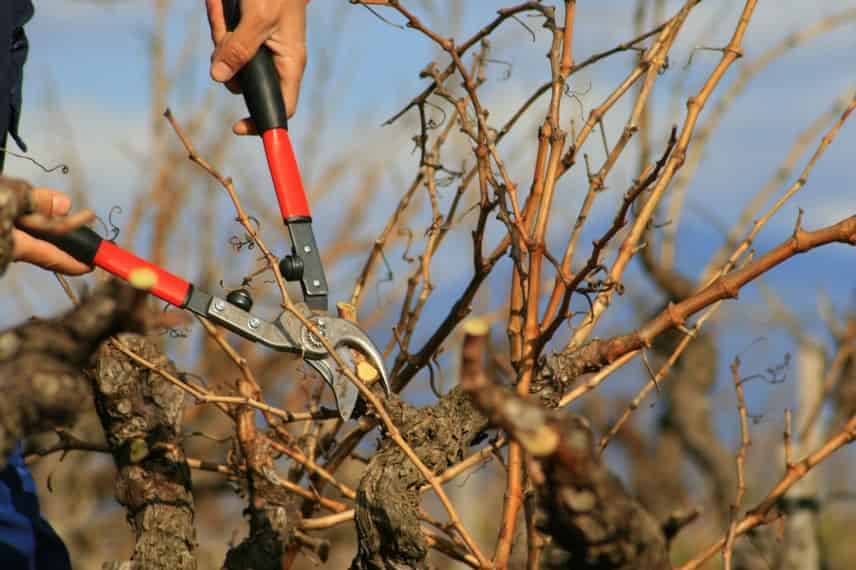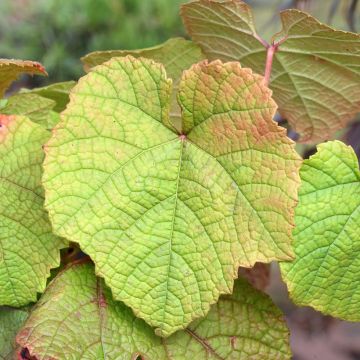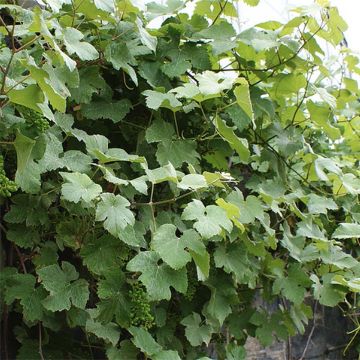
Vine: planting, pruning and care
Our tips for beautiful grape harvests
Contents
Growing one or more grapevines in your garden (and even in pots) and harvesting your own grapes is entirely possible, and this in many regions. Indeed, vine is a beautiful hardy climbing plant with woody climbing stems that fruits quite easily, provided it is planted in the right place and pruned properly. Discover all our tips for successful cultivation!
Where to plant a vine?
To plant your young plant of vine, choose a well-sunny location, ideally facing south, and sheltered from strong winds. The vine is a plant that loves heat and needs plenty of sun to produce sweet, ripe grapes. Also consider the climate of your region to select the right variety: early varieties, such as Chasselas or Muscat, will be better suited to colder regions, particularly in the north of France.
Soil plays a crucial role in vine cultivation. It prefers light, well-drained, and somewhat calcareous soil, but it can tolerate heavier clay soils, provided that water does not stagnate. If your soil is too compact or heavy, adding sand or gravel can improve drainage.
The vine needs a support to climb on. You have several options depending on your preferences: it can cover a facade, enhance a garden shed, or create shade on a pergola, gazebo, or fence. In addition to being ornamental, it can beautify and delineate different areas of your garden.
Finally, if you lack space or wish to enjoy grapes in the city, the vine grows very well in pots. Install it with suitable trellis on a balcony or terrace, and you can savour your own clusters right at home.

Cluster of grapes
When to plant a vine?
The ideal time to plant is in autumn, preferably between October and November. This period is perfect as it allows the vine to develop its roots before the arrival of the intense summer heat, thus facilitating better recovery in spring. If you miss this window, it is also possible to plant the vine in winter, provided you choose a time outside of frost periods. Frost can indeed damage young roots and compromise the growth of the plant.
Spring planting is also feasible, but it requires particular attention to watering, especially in the first few weeks, as conditions can be drier and the heat more intense.
Discover other Grapevines
View all →
Available in 1 sizes
Available in 1 sizes
Available in 1 sizes
Available in 1 sizes
Available in 1 sizes
Available in 1 sizes
Available in 1 sizes
Available in 1 sizes
Available in 1 sizes
Available in 2 sizes
How to plant it?
To successfully plant your vine-plant:
- Dig a hole 50 cm in all directions
- Place well-matured potting soil or compost mixed with garden soil at the bottom
- Position the young plant, ensuring not to bury the grafting point (3 to 5 cm above soil level)
- Fill in with soil
- Water generously
A first pruning is necessary at the time of planting:
- Cut above the 2nd bud to encourage the growth of 2 shoots
- At the end of the following winter, keep only one shoot: the most vigorous, and tie it to a stake. Remove the buds located at the bottom of the vine-plant.
How to prune grapevines?
Training Pruning:
There are several options for training a vine.
The simplest is to form a horizontal cordon, by bending the most vigorous shoot from the planting pruning at the desired height and tying it to a support. The buds on top should be spaced 25 to 30 cm apart. The length of a vine should be about 2 metres to produce good grapes.
You can also form a two-armed cordon, by selecting two eyes placed opposite each other, then tying a cordon horizontally to the left and another to the right.
Finally, another option is to construct a vertical framework (up to 2 or 3 metres) and tie the branches horizontally or in a fishbone shape.
Fruit-bearing Pruning (at the end of winter):
This pruning is done before the resumption of vegetation but after the severe frosts, that is to say in February or March depending on the regions.
The vine bears fruit on the shoots of the year, carried by the branches of the previous year. It is not possible to distinguish fertile buds from sterile buds, so it is necessary to identify the fruit-bearing shoots to remove them and the replacement shoots which will be shortened.
In the first year, prune according to the varieties:
- above the 2nd eye (Chasselas type varieties),
- above the 3rd eye (Muscat for example),
- above the 4th eye (large wood varieties).
If you prune to 4 eyes, remove the 2nd and 3rd buds (the same for pruning to 3 eyes, remove the 2nd bud).
This pruning will give rise to a fruit-bearing shoot and a replacement shoot.
Then, each year, cut the shoots that have already borne fruit.
Shorten the replacement shoots, pruning above the 2nd, 3rd or 4th bud according to the varieties and removing if necessary the intermediate buds, as in the first year. On these replacement shoots, the last bud (2nd, 3rd or 4th) will produce a new fruit-bearing shoot while the first bud will form a replacement shoot.
Green Pruning (at the end of spring):
In May-June, remove the “suckers” that grow in the axil of the leaves or along the vine-plant. Remove the small clusters. Pinch the shoots after the 2nd leaf following the last retained cluster.

Pruning the vine in winter – Photo: Jean-Louis Zimmermann
How to care for it?
During the first few years, while it is becoming well established, the vine needs to be watered regularly. Afterwards, it will show resistance to drought and will do without watering. Be sure to water at the base, avoiding wetting the foliage, to prevent the development of fungal diseases.
You can also enrich the soil with ground horn or chelated iron every 2 to 3 years.
To prevent the establishment of unwanted herbs at the base of your vine, we recommend installing a mulch, especially during the first few years.
The vine is susceptible to several diseases, including downy mildew and powdery mildew. As a preventive measure, spray Bordeaux mixture, sulphur, or horsetail manure, as preferred.
- Subscribe!
- Contents








































Comments